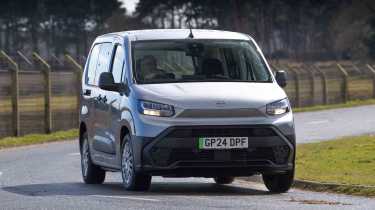Toyota Proace City Verso review
Van-based Toyota Proace City Verso electric MPV offers lots of space, but not much in the way of frills

Our opinion on the Toyota Proace City Verso
If you value space above all else from a new car, then the Toyota Proace City Verso offers it by the bucketload. It’s one of a number of van-derived MPVs that share common components, because it’s a product of Toyota’s joint venture with the Stellantis group to help fast-track the Japanese firm’s offerings in the commercial vehicle sector.
A recent update has boosted the model’s appeal with more tech, while the electric-only line-up is retained, as are short and long-wheelbase options. Thanks to the electric powertrain, the Proace City Verso offers a refined and responsive drive that is more pleasurable than any of the combustion-engined options that were once available. Only the relatively short range would leave you pining for the latter.
| Key specs | |
| Fuel type | Electric |
| Body style | Five-door van-based MPV, short or long body |
| Powertrain | 50kWh battery, 1x electric motor, front-wheel drive |
| Safety | Four-star Euro NCAP (2018, expired) |
| Warranty | Three years/60,000 miles (10 years/100,000 miles with annual Toyota servicing) |
About the Toyota Proace City Verso
In the contest for the new car with the longest name, the Toyota Proace City Verso Electric has to be a front runner. The reason for its length is because Toyota markets its smallest van as the Proace City to differentiate it from the medium-sized Toyota Proace, then the passenger variant adds the Verso tag, while Electric is added on the end to differentiate it from the combustion versions.
The last bit is moot because the current Verso is only offered in the UK as an EV, featuring a 50kWh battery and 134bhp/270Nm electric motor that drives the front wheels. What is on offer is two body lengths called Short and Long that offer five or seven seats, while sliding side doors boost access and the boxy dimensions maximise space.
Used - available now

2023 Honda
CR-V
31,062 milesAutomaticPetrol2.0L
Cash £21,700
2022 Volkswagen
ID.3
56,982 milesAutomaticElectric
Cash £12,600
2025 Toyota
Yaris Hybrid
20,000 milesAutomaticPetrol1.5L
Cash £16,100
2025 Audi
A5 Sportback
57,471 milesAutomaticDiesel2.0L
Cash £22,087There are two trim levels, Icon and Design, with the former offered in Short and Long guises, but offering pretty basic kit for a new car today. Design spec adds alloy wheels and some plusher materials inside, although it’s only offered in Short five-seat guise.
If the Proace City Verso looks familiar, that’s because it’s related to a number of other van-based MPVs. It was facelifted at the end of 2024 to have a look similar to other models such as the Toyota C-HR and Toyota bZ4x, but the main body and running gear are shared with Stellantis group models such as the Citroen Berlingo, Peugeot Rifter and Vauxhall Combo Life. There are only minor differences between them, boiling down largely to trims and finishes.
Performance & driving experience
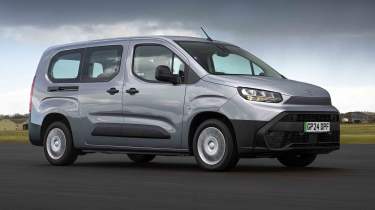
| Pros | Cons |
|
|
While there’s no diesel Proace City Verso, we can’t say that’s a great loss, because the electric version is pretty good to drive and eliminates a lot of the downsides that the combustion-engined powertrain brings to the mix. The Stellantis group has introduced an updated powertrain for its small models, but the vans and van-derived MPVs retain the old set-up. This features a 50kWh battery and a single electric motor with 134bhp and 270Nm of torque that drives the front wheels.
The Proace City Verso has a drive-mode selector that switches between Eco, Normal and Power modes, and it’s only the Power mode that offers the full output. In Normal, which is the default setting when starting the car, power is limited to 108bhp/210Nm. Eco reduces this further to 81bhp and 180Nm, while also limiting the car’s top speed and climate system. In both of these modes you can unlock full power by pressing the throttle past a kickdown-style step in its travel.
In reality, Normal mode is plenty for most needs, while Eco feels lethargic, which sees you end up accelerating harder to make up for the reduced power.
Electric motors, 0-60mph acceleration and top speed
Unlock maximum power, and the Proace City Verso doesn’t turn into a performance beast, and a 0-62mph time of 11.2 seconds is modest for an EV. Acceleration is quick off the mark, but it tails off as you reach higher speeds, and top speed is limited to 84mph to help save battery energy.

Town driving, visibility and parking
Massive windows mean there’s a clear view of your surroundings, which is handy because you only have rear parking sensors to help you when backing into or out of parking spaces. There are big door mirrors, too, although you don’t get the handy wide-angle lower mirrors that are common on some larger vans.
The steering is light, while the sharp throttle response at lower speeds means that it’s easy to keep pace with urban traffic. The ride is also well judged, largely thanks to the drive battery. Vans have suspension that’s designed to cope with heavy payloads, which often means they’re bouncy when unladen. But the weight of the 380kg drive battery helps to settle the Verso’s rear end, and when combined with the 16-inch wheels and tyres with high sidewalls, this makes for a comfortable set-up.
B-road driving and handling
It’s a similar story at higher speeds, where the Proace City Verso is a comfortable and refined machine. There’s some body roll, but not to such an extent that the car feels unstable, and the weight of the battery set low in the chassis boosts stability. The electric motor delivers just enough power to keep things interesting, but the eco-minded tyres don’t offer the last word in grip, although this isn’t really the sort of car that will have you exploring the limits of its ability.
Motorway driving and long-distance comfort
Things aren’t so refined on a motorway, with road and wind noise making their presence felt, especially around the door mirrors. The open body also amplifies things if you’re travelling unladen, because there isn’t much sound deadening to help matters. The ride remains comfortable even at motorway speeds, though, so only the drain on the battery when travelling at more than 60mph will prevent you from taking longer journeys.
Expert view, on driving experience
“If you described a car as ‘driving like a van’, it was meant to have negative undertones. However, the Toyota’s Stellantis-sourced platform is used by cars such as the last Peugeot 308 and Citroen C5 Aircross, and nobody could accuse those models of lacking in comfort or refinement.” - Dean Gibson, senior road test editor, spent a week with the facelifted Toyota Proace City Verso.
| Model | Power | 0-62mph | Top speed |
| Proace City Verso Electric | 134bhp | 11.2 seconds | 84mph |
Range, charging & running costs
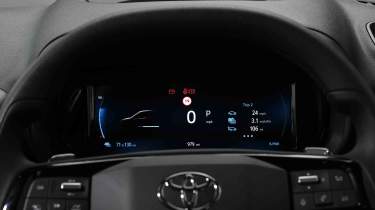
| Pros | Cons |
|
|
List prices start at around £32,000 for the Proace City Verso, which is around £10,000 more than you’ll pay for the entry-level Citroen Berlingo, but that’s because there’s no combustion-engined option in the Toyota line-up. Like for like, the Verso is priced very slightly higher than the Citroen, and on a par with the electrified Vauxhall and Peugeot alternatives. Some buyers are likely to be happy to plump for the Verso just to take advantage of the potential 10-year warranty that Toyota offers.
Electric range, battery life and charge time
There’s a 50kWh battery on board the Toyota Proace City Verso, and this is the only option available. The larger 54kWh battery used by other Stellantis models has yet to be carried over to the van/MPV line-up.
There’s a WLTP-tested range of 213 miles for the entry-level Proace City Verso, while the seven-seater Long version has a range of 211 miles. Moving up to the higher-spec Design version adds weight, so while it’s based on the Short (and therefore slightly lighter) body, this has an official range of 206 miles. It comes with a heat pump as standard (it’s not offered on Icon cars), so this range figure should remain consistent when the temperature drops, but either way, these aren’t particularly stellar figures. They’re largely in line with what the other Stellantis van-based MPVs can achieve, though.
We tested the updated Proace City Verso in seven-seat Icon trim in early March in cold conditions, and saw efficiency of 3.1 miles per kWh. This did include a variety of situations, including motorway work, but a projected range of 155 miles at that rate is well short of the official figures.
| Model | Battery size | Range | Insurance group |
| Proace City Verso Electric | 50kWh | 213 miles | 18-19 |
Insurance groups
The three versions of the Proace City Verso available at the time of writing fall into groups 18 and 19 for insurance, with the Design model and Icon Long both sitting in the higher group. Those ratings are actually a couple of groups lower than the mechanically identical Citroen Berlingo and Vauxhall Combo Life.
Tax
An electric van-based MPV is going to be a tempting company car for drivers with big families. Benefit-in-Kind (BiK) costs will be low, courtesy of the EV powertrain, while P11D prices are considerably lower than other seven-seat models that are available.
Road tax is charged at the standard rate of £195, with all versions coming in under the £40,000 luxury car tax threshold.
Depreciation
The Proace City Verso performs fairly well when it comes to how much it’ll be worth in three years’ time. A figure of 56 per cent for the seven-seat version is well ahead of the likes of the Citroen Berlingo and Peugeot Rifter, which have residuals in the low 40 per cent range. However, the Toyota can’t match the seven-seat Dacia Jogger, which is not only cheaper, but also has residuals of up to 68 per cent.
Interior, design & technology
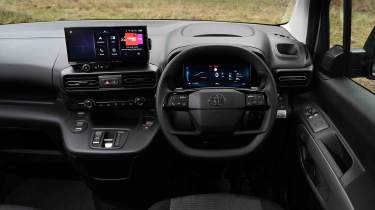
| Pros | Cons |
|
|
A van-derived MPV is never going to set the world on fire with characterful design, and that’s the case with the Toyota Proace City Verso. While it shares tech with a number of other models, the design of the Verso’s front end means that from the leading edge of the bonnet forward, Toyota has been able to give the car a unique nose. A facelift at the end of 2024 introduced a smoother design that replaced the pointed grille that featured before, but this has made it more generic than ever. Combined with the black bumpers and plastic wheel trims of Icon models, as well as a neutral colour palette, the Proace City Verso easily blends into the background.
Interior and dashboard design
A sea of black plastic greets you inside the Proace City Verso, and the layout is identical to the Citroen Berlingo’s. While the electric model doesn’t need a gearlever, the drive toggle sits in the same spot that a shifter would, with a prominent extension sprouting from the middle of the dashboard. The layout is fairly open, though, so at least there’s a sense of space around you.
Materials and build quality
Those hard plastics feel as if they’ll stand up to the rigours of family life, while the fabric seat trim gives the impression of being hard-wearing, too. Everything is well put together, with no squeaks or rattles, while the switchgear is functional and fuss-free.

Infotainment, sat-nav and stereo
As well as outsourcing the Proace City Verso’s running gear, the infotainment is sourced from Stellantis, too. It’s most obvious from the menus on the 10-inch touchscreen, where the interface uses the same fonts and graphics as those found in its Peugeot and Citroen counterparts. The system is fine on the whole, although the standard-fit sat-nav looks basic, but it gets the job done. You can bypass this and use your smartphone, though, and the screen resolution is good enough for clear mapping.
There are digital dials on a 10-inch display, and these are also configurable, although options are limited. The trip computer is included here, with control via the end of the wiper stalk.
Expert view, on design
“Toyota has tried to give the Verso a smooth nose to emulate the likes of the C-HR and bZ4x, but it looks generic. The headlights are a strange mix of halogen daytime running lights and LED main lamps, so there are distinct yellow and blue tints to the supposed white light. It’s not obvious when you’re driving, though.” - Dean Gibson, senior road test editor, spent a week with the facelifted Toyota Proace City Verso.
Boot space & practicality
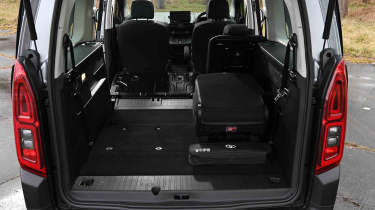
| Pros | Cons |
|
|
A van-based MPV is always going to deliver when it comes to practicality, and the Proace City Verso is a great choice for buyers needing lots of space. The cube-shaped body makes the most of the van’s dimensions, and there’s good room for passengers and luggage. The seven-seat version is based on the Long body, so that means the back seats aren’t crammed in and offer nearly as much room as those further ahead.
Dimensions and size
As you would expect from a platform-sharing enterprise, the Toyota matches its Citroen, Peugeot and Vauxhall relatives in terms of size, and all of them come in two lengths. Elsewhere, the VW Caddy/Ford Tourneo Connect are larger in every dimension, offering more overall space as a result. At the other end of the spectrum, the Dacia Jogger comes with a seven-seat layout, but in a more car-like shape that will demand more compromises.
| Dimensions | |
| Length | Short: 4,401mm, Long: 4,751mm |
| Width | 1,848mm |
| Height | Short: 1,812mm, Long: 1,818mm |
| Number of seats | Short: five, Long: seven |
| Boot space | Short: 597-983 litres, Long: 806-1,538 litres |
Driving position, seats & space in the front
The sense of space on board the Proace City Verso is enhanced by the tall roofline and large windows, while the driver’s seat adjusts for height to help with the view of your surroundings. Since the Toyota is derived from a van, there are plenty of storage spaces up front, including overhead shelves, a floor-mounted tray between the front seats, a shelf beneath a large glovebox, deep door bins, dashtop cup-holders and a lidded compartment above the dials.
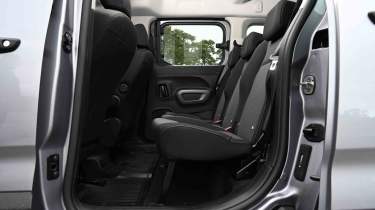
Seats & space in the back
The middle row is designed for versatility, so they're not the last word in comfort, but the three seats are the same size, so head, leg and shoulder space are all good. While there are door bins, there are no air vents, USB sockets or pop-out side windows. Unlike some MPVs, the seats don’t slide back and forth and are fixed in place.
There’s a good reason for this, because the seating system is sourced from the Crew Van that’s available within the Stellantis small van range, and rather than removing them for maximum boot space, they fold forward in a 60:40 split. The bases collapse into the footwells behind the front seats with the backrests sitting on top, which creates a completely flat floor. It’s a neat solution that’s easy to use.
This means it’s straightforward to access the rearmost seats, too. There are two individual chairs that are roomy and are flanked by two deep bins with cup-holders on top, plus a 12-volt socket to one side.
Boot space
The huge tailgate opens to reveal a super-low (and carpeted) boot floor and a massive amount of space, with 806 litres on offer in the Long model. The low floor does mean you’ll need to carry charging cables in the boot, though (there’s no storage under the bonnet, either), while the rearmost seats use traditional mounts, and need to be removed if you want to maximise space. The other option is to flip them up and forward, because this still leaves a decent amount of room at your disposal. There’s a rolling load cover that’s easy enough to stow inside, although there’s no dedicated space for it.
In two-seat mode, the Verso’s van roots are clear to see, with a colossal amount of space on offer. The middle row features metal seat backs, so it’s easy to slide items in and out when they’re folded flat.
Towing
Toyota doesn’t quote a towing capacity for the Proace City Verso Electric, so you’ll need to look towards the petrol version of Dacia Jogger that can handle a braked trailer or caravan of 1,200kg, or either a petrol or diesel version of Ford Tourneo Connect that can tow up to 1,500kg.
Expert view, on practicality
“In the past, van-based MPVs have been as basic as they come, with the same hard floors and wipe-down surfaces as their commercial counterparts. In the Verso, there are more concessions to luxury to help fill the void left by traditional MPVs, with carpets used throughout and higher-grade fabrics in important places.” - Dean Gibson, senior road test editor, spent a week with the facelifted Toyota Proace City Verso.
Reliability & safety
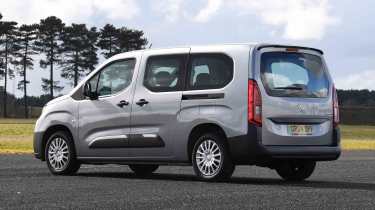
| Pros | Cons |
|
|
Joining forces with Stellantis fast-tracked Toyota’s entry into the small van/MPV market, while the strength in numbers afforded by the Verso and its relatives means that any issues should be resolved pretty quickly. The battery-only line-up means there should be less to go wrong, too.
There’s a four-star Euro NCAP rating for the Proace City Verso, which is the rating earned by a Peugeot Rifter and has then been applied to all the models that share the same technology. However, it was awarded in 2018, and the safety organisation’s statute of limitations means that this score has now expired. There’s still some useful tech on board, though, including hill-start assist and autonomous braking with pedestrian detection.
The Toyota brand came in a highly impressive eighth place out of 32 manufacturers in our 2024 Driver Power customer satisfaction survey. Customers praised quality and reliability the highest, followed by ride and handling, and running costs. They were less pleased with cabin storage and boot space, but we suspect this is due to other models in the Toyota range because the highly versatile Proace City Verso excels in these areas.
| Key standard safety features | Euro NCAP safety ratings |
|
|
Buying and owning
- Best buy: Toyota Proace City Verso Icon Long
The longer body offers more versatility, including a removable third row. It’s only available in base Icon trim, but that seems to suit the City Verso’s no-nonsense character.
Toyota has a three-year/60,000-mile warranty as standard, but if your car is serviced at an authorised Toyota outlet, you can add 12 months or 10,000 miles of warranty cover on top of that for up to 10 years or 100,000 miles. It’s testament to Toyota’s faith in the Stellantis-sourced running gear that this warranty offer applies as much to the Proace City Verso as it does to a C-HR or any other Toyota-developed vehicle.
Service intervals for the Verso are every 25,000 miles or two years, after an initial inspection at 12,500 miles/12 months. Toyota offers a five-year service plan that costs around £17 a month and covers two services and the first three MoTs.
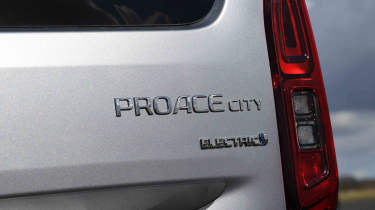
Alternatives
The most obvious rivals are the Stellantis machines that share the same running gear, namely the Citroen Berlingo, Peugeot Rifter and Vauxhall Combo Life. The Fiat Doblo also uses the same tech, but there’s no passenger-carrying version sold in the UK. One advantage that these three have over the Toyota is that they can be had with diesel power alongside their electric counterparts. If you’re only doing short distances, we’d stick with the electric for a smoother drive, but the extra range the diesels offer will be tempting for some.
Beyond these, the Volkswagen Caddy Life and Ford Tourneo Connect are two van-based MPVs that share the same technology. These aren’t available as EVs, but there are diesel and petrol plug-in hybrid options offered, as well as five and seven-seat variants.
There’s no passenger version of the Renault Kangoo van sold in the UK, or its Nissan Townstar and Mercedes Citan counterparts, and the only other real challenger is the Dacia Jogger. This comes in petrol and hybrid guises, but while it has seven seats, there isn’t as much space on board. It’s significantly cheaper than any of these van-based MPVs, though, especially the electric variants.
Toyota Proace City Verso pictures
Frequently Asked Questions
As with the rest of the Toyota line-up, the Proace City Verso qualifies for Toyota’s extended warranty. So while the standard cover is three years/60,000 miles, annual servicing adds 12 months or 10,000 miles of cover, up to a maximum of 10 years or 100,000 miles, whichever comes sooner.


